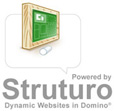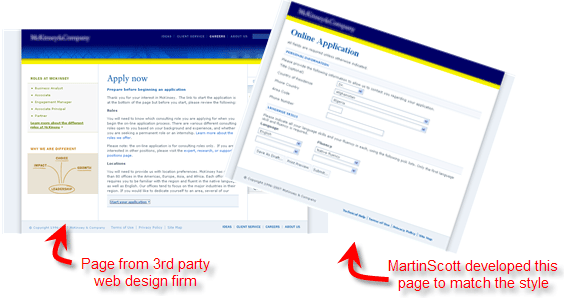Website Development
MartinScott Consulting has been developing business web applications since 1996. Our expertise includes all aspects of design, development, training, deployment, and support of mission critical websites.
Start with a powerful baseline
 MartinScott specializes in unified web content management systems (CMS) for decentralized organizations, such as large law firms, global consulting partnerships, and educational institutions. To implement enterprise websites, MartinScott employs the LavaTech Struturo framework, running on IBM’s Domino web server. MartinScott is a Premiere Struturo Partner and a design partner on the product. If the baseline configurability cannot do something you want, we can customize it to do virtually anything. Struturo and Domino run on Windows, Linux, Unix, and AS/400.
MartinScott specializes in unified web content management systems (CMS) for decentralized organizations, such as large law firms, global consulting partnerships, and educational institutions. To implement enterprise websites, MartinScott employs the LavaTech Struturo framework, running on IBM’s Domino web server. MartinScott is a Premiere Struturo Partner and a design partner on the product. If the baseline configurability cannot do something you want, we can customize it to do virtually anything. Struturo and Domino run on Windows, Linux, Unix, and AS/400.
Examples
The following are examples of websites developed by MartinScott and/or with the Struturo web content management system.
- Pillsbury Winthrop Shaw Pittman — For this top 20 law firm in the US, MartinScott’s web team worked with the in-house developers and an outside design firm to build a comprehensive enterprise website with a custom content management system in Lotus Domino. Lawyer Bios and other structured pages all conform to a standard format, while the content within each can be edited directly by the individual lawyer without HTML knowledge. MartinScott provided web design & development, project management, requirements gathering, style sheet development, site search, email subscription, and various integration programming tasks.
- Alumni Center — University of Maryland’s Robert H. Smith School of Business — MartinScott’s implementation partner, LavaTech, used the Struturo framework to build this site, where Alumni profiles and news are served and managed by the Lotus Domino web server.
- Networth MBA community — University of Maryland’s Robert H. Smith School of Business — MartinScott’s implementation partner, LavaTech, used the Struturo framework where non-web authors can enter new pages easily, without messy and error-prone HTML.
- NoteMan — MartinScott’s leading toolbar for Lotus software professionals has a website developed entirely with the Struturo framework.
- Other sites developed with the Struturo framework. Note that all of these are created with the same web CMS. The different appearance of each is attributed to the configurable art, style, navigation, and content.
The Process
Every website project is different, but these are some common steps for a large enterprise website. Steps 2 through 8 are typically revisited once or twice to ensure thoroughness.
- Identify constituent focus groups for content ownership and site visitors.
- Organize a tree of website objectives from your organization’s leadership.
- For each focus group, define a comprehensive set of “Use Cases”, each one of which represents a reason why someone would interact with the website. These Use Cases are evolved and refined throughout the project. They are the context in which all design decisions are made. The resulting site architecture will reflect the site objectives, ensuring intuitive and optimal website experiences.
- Gather requirements from each group. Identify areas of commonality, as well as attributes unique to each group.
- Generate best practices for standardized page templates. Rapidly prototype these common page templates to build consensus within relevant focus groups.
- Prototype the working site gradually through several rounds of iterative development and feedback. Careful attention to the specific operations of each department, combined with judicious applications of leading edge web editing technologies, will facilitate ongoing and hassle-free publishing of fresh content with minimal effort.
- Assist staff with content population and migration, including resolution of content migration artifacts.
- Test and pilot the website among a subset of users.
- Deploy the site.
The Pieces
Several components of a website work in harmony to provide presentation, function, performance, and promotion.
- Art — logos, illustrations, photographs
- Style — layout positioning, color schemes, fonts, borders, text styles (CSS)
- Navigation — menu structures, navigation conventions (DHTML)
- Content — engine for content creation, editing, approval, publishing, and archiving
- Metadata — search engine optimization (SEO) strategies for high site rankings
- Interactivity — email subscriptions, forums & comments, submission of forms, searches, user ratings of content, etc.
- Integration — tapping into existing back-end databases across the institution (registration, events, financials, alumni, etc.)
- Security — which roles can do which actions to which types of information, integration with existing directories, single password sign-on
The People
The web architect is the most critical ingredient for success in the eyes of both site stakeholders and site visitors. This critical role works with all website constituent groups, identifying patterns of common structure, while embracing differences between unique sections of the site. Much like the work of a building architect, a successful website framework is a marriage of each stakeholder’s need to the capabilities and limitations of the web. This role requires listening and interpersonal skills, information analysis, and a solid working knowledge of web technology. MartinScott’s lead web architect is a seasoned enterprise website developer, experienced requirements analyst, and an acclaimed lecturer on web development topics. This unique marriage of technical and people skills leverages past experiences on similar website issues, affording faster conclusions to complex issues of enterprise site design.
The Technology
All websites developed by MartinScott under the Struturo framework…
- are web standards compliant, including CSS and XHTML
- work on any browser, including mobile devices
- are 100% customizable (no layout restrictions)
- run on any major server platform, including Linux, UNIX, Windows, AS/400
- are backed by IBM web server technology
- can run in server clusters for maximum availability and performance
- can integrate with other systems via numerous industry standard languages and protocols
- can allow authentication including from an existing external LDAP directory
Bring your own template (BYOT) optional
On larger website projects, perhaps you have an existing relationship with a trusted firm for artwork and/or web layouts. This is often the case in the redesign of an existing site, where you wish to reuse one or more styles from the old site. Or, a totally new style needs to maintain your branding guidelines such as colors and logos. In these scenarios, MartinScott collaborates closely with your design firm to apply artwork and/or web templates to our state of the art technical framework. Where appropriate throughout all phases of the site design, MartinScott guides aesthetic decisions toward a final product that is useful, economical, future proof, and technically robust. You can also select from a wide array of publicly available website templates. We use will your selected template to “skin” your website for a combination of ready-made aesthetics and robust custom content management.

Partner with the best
Our vast experience with Struturo, Lotus Notes & Lotus Domino in dozens of commercial and government environments has made MartinScott the ideal partner for organizations looking to leverage the power of an enterprise content management solution. Contact MartinScott today for a free consultation on your next web project.
Locations
Headquarters / DC
Tel: 703-462-5435
Fax: 703-995-4738
Seattle
Tel: 253-234-5390
Fax: 703-995-4738
Philadelphia / Delaware
Tel: 571-432-7135
Fax: 703-995-4738
Call our dedicated team for help today 703-462-5435

Our Offices
Washington DC
Tel: +1 (703) 462 5435
Philadelphia
Tel: +1 (571) 432 7135
Seattle
Tel: +1 (253) 234 5390
contact@martinscott.com
Fax: +1 (703) 995 4738
